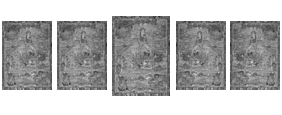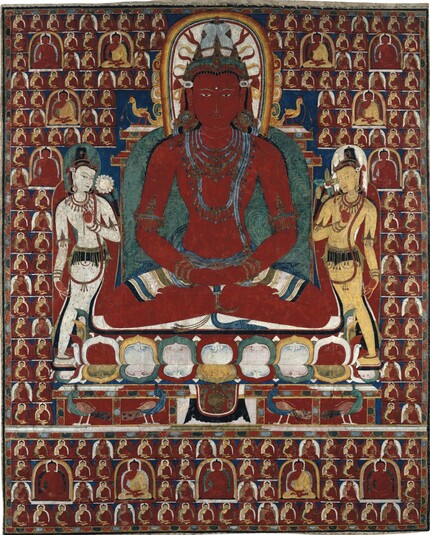
Item: Amitabha Buddha - Sambhogakaya
| Origin Location | Tibet |
|---|---|
| Date Range | 1300 - 1399 |
| Lineages | Buddhist |
| Material | Ground Mineral Pigment on Cotton |
| Collection | Private |
Classification: Deity
Appearance: Peaceful
Gender: Male
Amitabha, Buddha (English: the Enlightened One of Immeasurable Life) adorned with sambhogakaya vestments, jewels, garments, and accompanied by two standing figures and 102 Buddhas, fourteen large and one hundred and eighty-eight small. (See the Amitabha Buddha Main Page and the Outline Page).
It is very likely that this composition belongs to a set of five paintings depicting the Five Families of Transcendent, or Symbolic, Buddhas: Vairochana, Akshobhya, Amitabha, Ratnasambhava and Amoghasiddhi. It is also possible that the composition is based on a Tantric text belonging to the Charya or Yoga classification system.

Amitabha is red in colour with one face, two hands folded in the lap, and the legs folded in vajra posture. He has the appearance of a Peaceful Deity with long hair, a crown, earrings, jewelry, and heavenly garments. At the proper left side of the Buddha is the standing figure of Avalokiteshvara, white in colour, holding a white lotus flower, wearing the same ornaments and garments. On the left side is Maitreya, yellow in colour, with a water flask on a flower blossom, otherwise is similar appearance. The throne below is supported by four peacocks
There are many different forms and types of Buddhas represented in Buddhist art. Following after the many images of the historical Buddha Shakyamuni the next most common Buddha form to appear in art is likely to be Amitabha (immeasurable light). His popularity is based in the Mahayana Sutra literature of which there are several Sutra texts devoted to him, along with numerous commentaries and meditation and ritual texts. Amitabha typically has the appearance of a standard buddha form called nirmanakaya appearance. In this form he is red in colour, wearing the traditional patchwork robes of a monk. This latter form is known as sambhogakaya appearance. The nirmanakaya form is the same as the classical Buddha Appearance. The nirmanakaya form is in Peaceful Deity Appearance, sometimes referred to as Bodhisattva Appearance. There are many additional forms of Amitabha contained in the Tantric literature.
Jeff Watt 1-2013 [updated 6-2021]
Subject: Five Buddhas (Early Painting Sets)
Collection: Private 1
Buddhist Deity: Amitabha Buddha Main Page (阿弥陀佛 / འོད་དཔག་མེད།)
Buddhist Deity: Amitabha (Sarvadurgati Tantra)
Buddhist Deity: Amitabha Buddha, 阿弥陀佛, འོད་དཔག་མེད། (Painting Masterworks)
Buddhist Deity: Amitabha (Charya & Yoga Tantras)
Subject: Five Buddhas Main Page (Directions, Tantric, Symbolic)
Subject: Torana, Amitabha & Amitayus Buddha (Early Animal Depictions)
Subject: Tatagatas & Figures (Similar Characteristics)
Buddhist Deity: Amitabha Buddha (Early Paintings)
